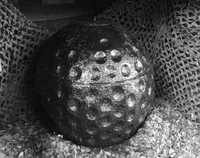- Author
- Nicholls, Bob
- Subjects
- Naval Aviation, WWII operations, History - WW2
- Tags
-
- RAN Ships
- None noted.
- Publication
- September 2010 edition of the Naval Historical Review (all rights reserved)
Narellan, south west of Sydney, is the site, at the local airport, of the Camden Museum of Aviation, which houses a collection of some 22 vintage aircraft. One of these flying machines, now in an advanced stage of restoration, is a DeHaviland DH 98 Mosquito FB Mk VI twin-engine fighter bomber. This machine is apparently the sole survivor of the Royal Air Force’s World War II 618 Squadron, whose role was ‘Most Secret’ until declassified under the British ‘30-year rule’ in 1973.

They were responsible for operating one of the ‘also rans’ of the War – the Highball bomb/mine.
The weapon was the ‘lite’ version of the much more well-known Upkeep, the code name for the ‘bouncing bomb’ used to great effect by the Dambusters in their attacks on the hydro-electric dams in the Westphalia area of Germany. Before the outbreak of the War in 1939 the British Government had decided to strike at the German infrastructure through attacking the country’s production of electricity. Attacking coalfields was impractical and oilfields were outside the range of the aircraft then in service in the RAF. Experiments to demolish dams showed that an impracticably high number of conventional bombs would be required with a very limited chance of success.
Enter Barnes Wallis, an engineer and inventor employed by Vickers. He had already been responsible for developmental work on airships in the 1920s and his Wellington bomber, designed along his principles of airframe construction, was in (although not outstandingly successful) service with the RAF. In the immediate pre-War period he has been investigating the possibility of utilising the skipping properties of an object over a water surface.
The concept of a bouncing weapon was not new. Naval gunners had long ago discovered that they could increase the range of cannon balls by bouncing them off the water like a stone in a pond. However, the concept of the device that Barnes Wallis invented was a lot more complicated. Confirming his research were reports from British pilots early in the war who said that even if they dropped their bombs short of enemy shipping they were attacking, they would sometimes skip on over the water and, given the right conditions, still hit the target.
Knowing that he had to get the bombs to detonate right up against a dam with the nearer the detonation was to the bottom of the water the more effective it would be, he began to develop the concept.
Wallis began his experiments with bouncing bombs at his home in Surrey. He used his daughter Elizabeth’s marbles to bounce off the surface of a metal tub and land on a table further on. He soon extended his experiments to the Admiralty Research Laboratory ship testing facility at Teddington, west of London. Using their 670 foot long water tank, Wallis bounced many different spheres of various design and of various materials including smooth, grooved and even dimpled balls (similar to golf balls). He discovered that the ball must hit the water at a certain angle otherwise it would dive straight into the water without bouncing.
The critical angle for the ball to bounce was about 7 degrees. This angle of impact had great implications as to how high the bomb would have to be when it was dropped. Wallis also discovered that applying backspin to the sphere gave better results. If the sphere was spun backwards, it bounced better because it was more inclined to rise off the surface of the water. The backspin also increased the distance the sphere would travel due to the improved bouncing effect. Also, after a certain number of bounces, the sphere would decelerate enough so that it would sink at the wall of the dam and not overshoot it.
In June 1942, after encouraging results from the test tank in Teddington, Wallis presented his ideas, along with the test results, calculations and designs at a meeting with the Air Ministry, the Ministry of Aircraft Production, and the Admiralty. The Royal Navy had, it is assumed, by now read his paper Spherical Bomb – Surface Torpedo of April of that year. In it he described the attack on a battleship by bouncing a weapon on the surface of the water, striking the ship, and then dropping to explode at a depth where the hull is less protected. Exploding these weapons underneath a target’s hull also took advantage of the bubble pulse effect typical of underwater explosions, which greatly increased their effectiveness.




